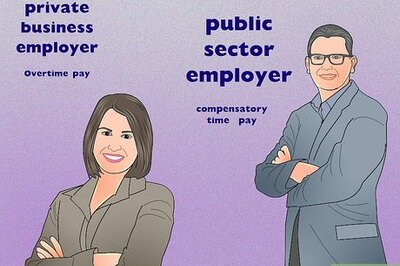
views
As the Covid pandemic raged on, Mumbai’s civic body – Brihanmumbai Municipal Corporation (BMC) – set up eight jumbo Covid centres or field hospitals, with a total of 12,375 regular beds and 907 ICU beds.
Over the past two years, lakhs of patients were treated at these centres, with the civic body also opening up inoculation centres there.
Two years on, the civic body is set to shut all its jumbo centres, as cases have consistently declined over the past few months according to the BMC.
While Dahisar, NESCO Centre, Goregaon and Kanjurmarg jumbo centres were closed in the first phase, Worli, Bandra-Kurla Complex (BKC), Byculla, Mulund and Malad will be closed in the second phase.
According to the BMC, even after the closure, 11,165 beds will be available across hospitals in the city for Covid-19 patients and if necessary more beds will be added.
On July 28, according to the BMC, Mumbai reported 281 new cases, taking the tally to 1,123,915.
A timeline of Mumbai?s fight with Covid, the highs and lows:
The First Case: On March 11, 2020, Mumbai detected its first case, when the virus was still a mystery. The first two cases of coronavirus in Mumbai had come in close contact with two Pune residents who were the first confirmed cases of Maharashtra and had tested positive after returning from Dubai.
In the initial days of the pandemic, suspected cases were isolated in the civic-run Kasturba Hospital, and tested.
May 18, 2020: The civic body set up its first jumbo Covid centre at BKC.
Jumbo facilities created in Mumbai for treating COVID patients;The first open hospital in the Country has been created in a fortnight by the @MMRDAOfficial at the BKC. This 1,000 bed jumbo facility includes a 200 bed ICU. pic.twitter.com/Xo2Eq6gZGf
— CMO Maharashtra (@CMOMaharashtra) May 25, 2020
March-August: The allotment of beds was first centralised. On August 10, the BMC created 24 ward rooms and decentralised the system. As cases started to rise, the BMC started jumbo centres at Mulund, Dahisar, Kanjurmarg and NESCO.
Such field hospitals are an essential part of an administrative response to a medical emergency. I can’t not mention @DrMuffi and @UghadeSharad ji for the NSCI dome field hospital which is still a role model while we made these (4/n) pic.twitter.com/qEDHBn7jmY— Aaditya Thackeray (@AUThackeray) July 7, 2020
June: By June 30, Mumbai had reported 4,554 deaths, more than 25% of the country’s total 16,893 fatalities. The highest number of deaths reported in a day in the city was 136 in June 2020.
May-Oct: The city crossed 1,000 Covid deaths in May, around 5,000 deaths in July, and crossed the 10,000-mark by October-end.
July 7: Mumbai became the first city in India to open up testing.
September: India faced its first wave of coronavirus in September 2020
Second and Third wave: The second wave began in March 2021 and reached its peak in April. While the first wave hit the densely populated slum clusters and chawls, including Dharavi and Worli Koliwada the worst, in the second and third waves, a majority of the cases were found in high-rises.
While the second wave saw Mumbaiites looking frantically for ICU beds, ventilators and oxygen, the third wave was considerably smoother, with at least 80% at some point.
Vaccination programme was rolled out during the second wave.
April 2021: Mumbai reported 1,479 deaths as the second wave of the infection was heading towards its peak. In May, the city recorded over 1,700 deaths. Mumbai witnessed 625 deaths in June while the toll dropped to 438 in July. In August, this came down to double digits at 77 deaths.
June: The city crossed the 15,000-Covid deaths mark.
December 2021: As the third wave began, the city was 100% vaccinated with the first dose and 90% had got their second dose.
#COVID19 | Has The Mumbai Wave Flattened?Listen in to what Member COVID Task Force @AskDrShashank has to say on the same!
Watch #News18Debrief with @shreyadhoundial pic.twitter.com/U3Bngyry11
— News18 (@CNNnews18) January 11, 2022
April 2022: Mumbai became the first metro city in India to fully vaccinate its eligible adult population against Covid-19.
June 2022: In a letter to Tamil Nadu, Kerala, Telangana, Karnataka and Maharashtra, Union Health Secretary Rajesh Bhushan highlighted that a few states were reporting a higher contribution to India’s caseload, indicating the possibility of a localised spread of the infection.
The challenge named Dharavi: The slum, said to be Asia’s largest, fought a tough battle with the virus. Dharavi has a population of 6.5 lakh, which means 2,27,136 people living per sq km. Social distancing was next to impossible in Dharavi, where families of eight to 10 people live in 10×10 hutments.
The detection of first case of coronavirus in Dharavi in April 2020 was a matter of concern. However, Mumbai authorities’ trace-track-test-treat method helped them stop the spread of the virus and soon the ?Dharavi model? began to get plaudits.
#NewsAlert – Dharavi’s fight against Covid-19.Festive Season brings joy.
Decoding the Dharavi Model.@mihirz brings you a report from Mumbai.
Join @SiddiquiMaha on #News18Debrief. pic.twitter.com/owQLTLMTM0
? News18 (@CNNnews18) November 16, 2020
Kiran Dighavkar, assistant municipal commissioner of G-North ward that houses Dharavi, had said last year that despite a slow spread of the virus in December 2020 and early January 2021, “we continued with comprehensive testing and tracking of cases in Dharavi”.
With the onset of the Covid-19 second wave in February 2021, the Dharavi Model was activated again to stem the spread of the infection, he said. “Door-to-door screening of people with symptoms, aggressive testing, regular screening and testing of Dharavi residents who work in different parts of Mumbai, including delivery personnel, industrial workers, helped to control the spread of the pandemic,” Dighavkar said.
July 29: Mumbai is set to shut down jumbo Covid centres. The BMC, however, said that the Somaiya jumbo centre in Mumbai’s Sion will be kept ready in case a necessity arises. Meanwhile, Covid treatment will be provided to patients at the four main civic-run hospitals and 16 suburban hospitals besides the Kasturba hospital in Chinchpokli.
Read all the Latest News and Breaking News here




















Comments
0 comment